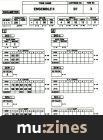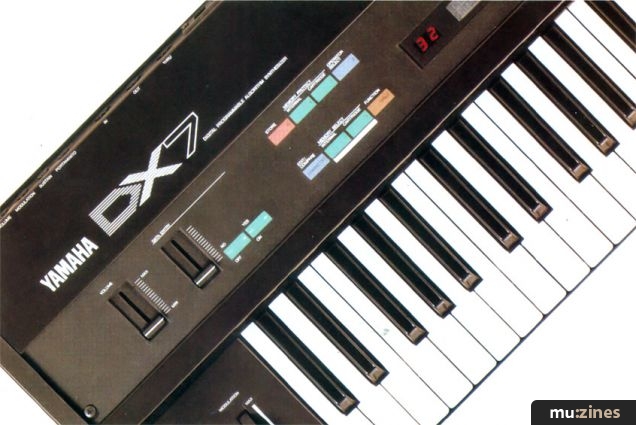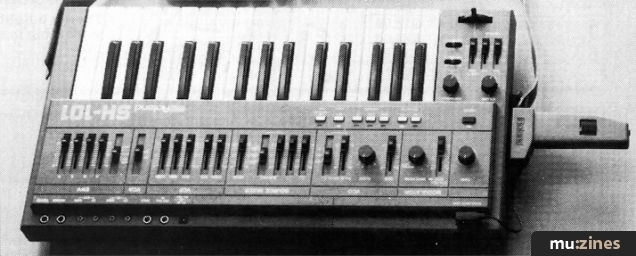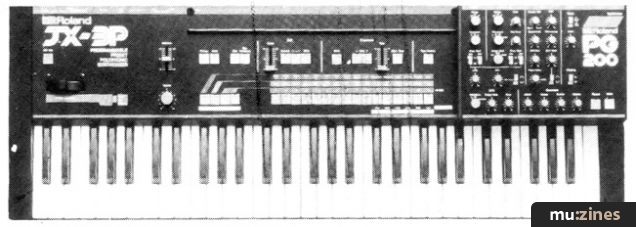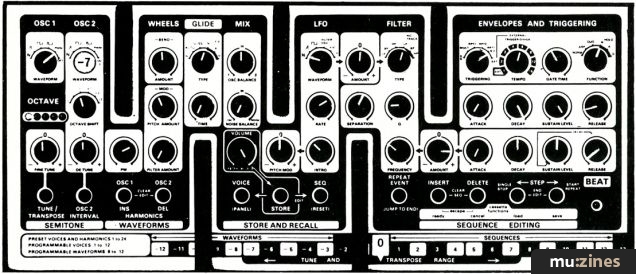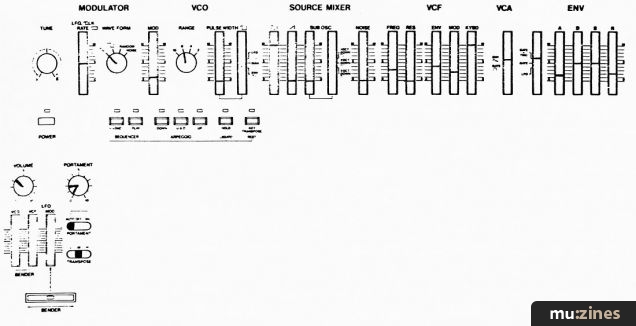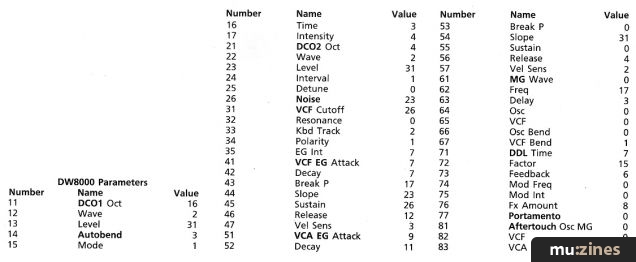Magazine Archive
Home -> Magazines -> Issues -> Articles in this issue -> View
Patchwork | |
Article from Electronics & Music Maker, March 1984 | |
Funk Bass for DX7
Martyn Phillips

First of all, our apologies to Martyn Phillips, the creator, and to all DX7 owners who attempted to use his patch we printed in last month's issue. Due to circumstances beyond our control several parameter values were printed incorrectly, while others were omitted altogether. The correct patch reads as follows:

(Click image for higher resolution version)
Bass Synth for Korg Polysix
Patricia McGrath, E&MM
The Korg Polysix is capable of providing fat bass synth sounds in the Unison mode (where its six voices are assigned to one note ie. playing monophonically), and an even thicker sound can be produced by selecting 8' Octave and using the Sub Oscillator to provide the lower 16' frequencies.
The Cutoff Frequency is set quite low to give a rounder sound, so it may be necessary to store this patch with the Attenuator at around +6dB in order to balance its level with previous stored programs. Envelope settings (particularly the release time which can vary depending on the bass riff being played) and the Cutoff Frequency controls are best fine-tuned to taste, and bass lines constructed over the lowest octave and a half of the keyboard.
The (non-programmable) Pitch Bend should be set to bend a precise semitone for a realistic 'fretless bass' effect (see Guide to Electronic Music Techniques, E&MM Feb '83, for a guide to Pitch Bend and performance control technique), and the MG Frequency (LFO) control programmed at a moderate speed if use is to be made of the VCO Modulation Wheel. Remember that bass players cannot bend thick bass strings easily!

(Click image for higher resolution version)
'Stringbell' for Yamaha DX7
Ken Campbell
Continuing the DX7 theme (will owners of other synths break the domination next month? We ask ourselves) an interesting patch from reader Ken Campbell:

(Click image for higher resolution version)
This is a good demonstration of the purely synthesiser capabilities of the DX7, rather than the imitative ones which have been used to form the vast majority of the presets. It is neither a string sound nor a bell sound, but displays characteristics of both plus some of its own.
Algorithm six consists of three pairs of modulator-carrier configuration each with a different fundamental and a different frequency ratio. All the carrier envelopes have a fast attack which provides a chime-like quality to the start of the sound. Looking at the modulators, although 4 and 6 have the same attack as the carriers, the attack levels are quite low, and it is the climb up to level two which provides the rush of different harmonics that give the sound its main character. The late entry of operator 2 gives the impression of movement within. As the sound settles on level 3 it leaves a hollow harmonic sound that almost, but not quite, obliterates the fundamental.
If you use a sustain pedal with your synth, you will find that occasionally, depending on how you pedal it, a second wash of sound rolls after the first couple of seconds later. It does not work if you merely hold the pedal down continuously. I have no explanation for this, but would be interested to hear one.
Also try this sound an octave up and/or with operator six frequency set to 0-75.
SCI SixTrak
Finally, and most topically, a patch for Sequential Circuits' latest polysynth, the Six-Trak, like the Polysix patch above, makes use of a polyphonic keyboard's unison mode.

(Click image for higher resolution version)
Program six different voices with identical parameters except for Parameter 01 (Fine Frequency). Set Voice 1 at 00, Voice 2 at 01, Voice 3 at 02, and so on up to Voice 6 at 05. This means that when you stack all six voices together, the maximum richness of sound is obtained from the 6 oscillators all slightly de-tuned from each other. Other things which make this sound MiniMoog-like are the bit of noise added (Parameter 18), Ring Modulation (Parameter 29), Pulse Width Mod (Parameters 13,14,15,16, and 17) and the hint of Glide (Parameter 2). Liberal use of the bend wheel is suggested, along with legato playing over the whole keyboard to bring out the gliding.
More with this topic
Patchwork |
Patchwork |
Patchwork |
Patchwork |
Patchwork |
Patchwork |
Program Notes |
Patchwork |
Patches |
Patches |
Patchwork |
Patchwork |
Browse by Topic:
Synthesizer Patches
Also featuring gear in this article
BeeBMIDI (Part 3)
(EMM Aug 84)
BeeBMIDI (Part 7)
(EMM Mar 85)
Hands On: Yamaha DX7
(SOS Dec 92)
Korg Poly-800 vs SCI Six-Traks
(ES Jun 84)
Korg Polysix
(EMM Aug 82)
Load Baring
(12T May 85)
Load Baring
(12T Aug 85)
One For The 7 - DX7 Patch
(ES May 85)
One Off - DX7 Patch
(ES Apr 85)
Sequential Circuits Six Trak Polysynth
(EMM Mar 84)
Sequential Six-Trak
(12T Apr 84)
Sight Reading - Yamaha DX7 Digital Synthesizer
(EMM Apr 85)
Steve Gray on the DX7
(EMM Dec 83)
The Right Connections
(ES Oct 84)
Patchwork
(EMM Feb 84)
Patchwork
(EMM Apr 84)
Patchwork
(EMM May 84)
Patchwork
(EMM Jul 84)
Patchwork
(EMM Aug 84)
Patchwork
(EMM Sep 84)
Patchwork
(EMM Dec 84)
Patchwork
(EMM Jan 85)
Patchwork
(EMM Feb 85)
Patchwork
(EMM Apr 85)
Patchwork
(EMM Jun 85)
Patchwork
(EMM Jul 85)
Patchwork
(EMM Feb 86)
Patchwork
(EMM Mar 86)
Patchwork
(EMM May 86)
Patchwork
(EMM Jun 86)
Patchwork
(EMM Aug 86)
Patchwork
(EMM Sep 86)
Patchwork
(MT Nov 86)
Patchwork
(MT Dec 86)
...and 19 more Patchwork articles... (Show these)
Browse category: Synthesizer > Yamaha
Browse category: Synthesizer > Korg
Browse category: Synthesizer > Sequential Circuits
Publisher: Electronics & Music Maker - Music Maker Publications (UK), Future Publishing.
The current copyright owner/s of this content may differ from the originally published copyright notice.
More details on copyright ownership...
Topic:
Synthesizer Patches
Gear in this article:
Synthesizer > Yamaha > DX7
Synthesizer > Korg > PolySix
Synthesizer > Sequential Circuits > Six Trak
Gear Tags:
Feature
Help Support The Things You Love
mu:zines is the result of thousands of hours of effort, and will require many thousands more going forward to reach our goals of getting all this content online.
If you value this resource, you can support this project - it really helps!
Donations for April 2024
Issues donated this month: 0
New issues that have been donated or scanned for us this month.
Funds donated this month: £7.00
All donations and support are gratefully appreciated - thank you.
Magazines Needed - Can You Help?
Do you have any of these magazine issues?
If so, and you can donate, lend or scan them to help complete our archive, please get in touch via the Contribute page - thanks!




 Upload an audio preview and/or patch preset file for this patch
Upload an audio preview and/or patch preset file for this patch





